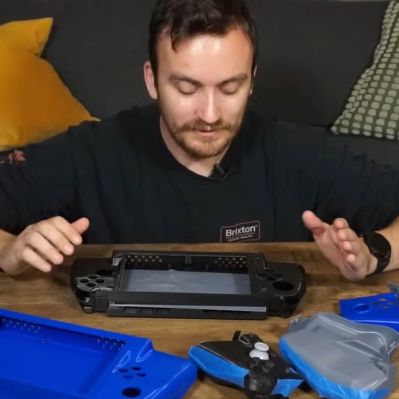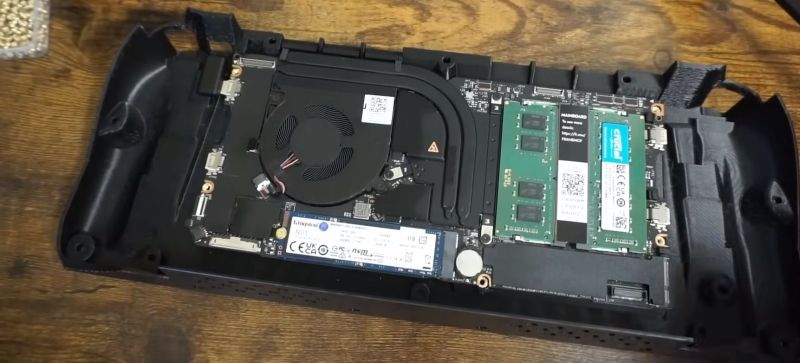
Building your own handheld gaming console has been a popular project for many years, but recently it has become significantly easier to get a lot of power into a small package. Like many others, [TommyB] made his own Raspberry Pi SBC-based handheld in the past, which results in a rather bulky and underpowered package. A more performant solution would be to stuff laptop guts into a handheld case, but until Framework came onto the scene this wasn’t easy and would get you a sloppy one-off solution. With [TommyB]’s current handheld project he uses a standard Framework laptop mainboard, along with the official battery to get a very capable gaming system.
Getting the ergonomics and fit for the components just right took many tries, but eventually a prototype shell was designed that fits the Framework mainboard, the battery, twin Framework speakers, an 8″ LCD panel from Waveshare (connected via USB-C to HDMI) and mechanical switches for the buttons. These switches connect to an RP2040-based board that runs the GP2040-CE firmware, allowing the operating system to detect it as an XBox controller. Although still far from finished, it shows just how beneficial standard laptop parts are, with a massive gap in the market where Framework could make its own handheld shell available. We’re looking forward to [TommyB] demonstrating the finished version of his Framework handheld, and the inevitable upgrade from the 11th-gen Intel mainboard to one of the sparkling new mainboards with even better specs.
Thanks to [Keith Olson] for the tip.
















This isn’t the first or the last attempt. Each one has its faults and strengths.
https://youtu.be/dDPA2LtZ6RI?si=hDqHEGNLGPVKCNTy
https://youtu.be/NTkb0HOr6Qk?si=thU03-Iral_Ah1Nh
This is something I wish I could do, I’d buy the parts kit in a heartbeat if the dang framework motherboards weren’t so expensive.
For what you are getting they seem pretty darn reasonably priced to me. Sure its not got the performance to cost ratio of some of the more subsidised or mass produced budget end machines, but it isn’t unreasonably marked up. If you really want to do something similar to this cheaper your best option looks to be a second hand laptop to gut – and that while cheaper to buy the hardware it won’t be upgradeable, could be a massive pain to get a different screen to run, and you have to do all the work again every time you change the source laptop.
The LattePanda boards are smaller and performant enough to make an emulator system out of, if not any less expensive. Still I applaud Framework for selling the boards separate from the laptop itself. The 11th gen i7 board is $300, which is not bad for a complete, very powerful board that you can build a system around easily.
My biggest concern with any of these i5 and i7 based handhelds is heat and fan noise. For an emulator, the fanless N100 would do fine and you can get something like the Mele Quieter 4C for under $200. It’s small enough to make a PS Vita sided handheld once you remove the shell.
Indeed, there are some other great options you could do this idea with. However few of them are likely to make your system upgradeable in the future, so the framework might make sense for that alone.
I’d not be too concerned about the framework cooling noise, seems users of the original machines don’t think them too loud (no personal experience though I’d like to get one someday). So especially if you do the sane thing and get the AMD 13″ as AMD atm is so much more power efficient and comes with a really powerful iGPU I doubt that would be a problem at all – may even be plausible to passively cool that AMD one.
That said fanless if you can go fanless and still get enough cooling to maintain the required performance for your usecase it is IMO always worth it. And there is no point buying a more powerful brain unless it is cheaper/more energy efficient.
I think the design has two major flaws but I’m not sure with the info I have.
1st is the use of USB-C to HDMI adapter. I don’t know if this the specific case, but I’ve experienced a poor experience with this type of adapters in the past (low refresh rate and other related issues).
2nd is the use of an intel CPU, that in this kind of computers usually comes with an intel GPU, and intel GPUs sucks at gaming due their poor performance, terribly bad drivers and so.
Intel integrated graphics while not high performance have a long history of good support, and the discreete Intel Arc stuff is getting really good it seems after a slightly rocky launch – so for many handheld gaming usecases will be fine.
I’m certainly not a fan of USB-C for everything incompatible dongle madness that seems to sweeping through, but when you actually have a device on both ends of a cable that supports everything you need USB-C isn’t bad. However while USB-C to HDMI could be a problem, but so far until the USB cable starts failing I’ve had no trouble with it at all myself. I’d expect your issue is that the port you are using doesn’t have the bandwidth to do higher refresh rate at high pixel count – which will be a common problem. As the bandwidth available to your port, cable quality etc plays a big part in what is possible via USB-C, and as nothing is ever clearly labelled so you know what to expect out of the ports or cables and in many cases a device has different levels of feature support and bandwidths on every single USB-C port… Frameworks are better at this in that on the 13″ I believe every port is identical in functionality and the 16″ isn’t quite the same but similar – I believe only two ports are USB4 in that case.